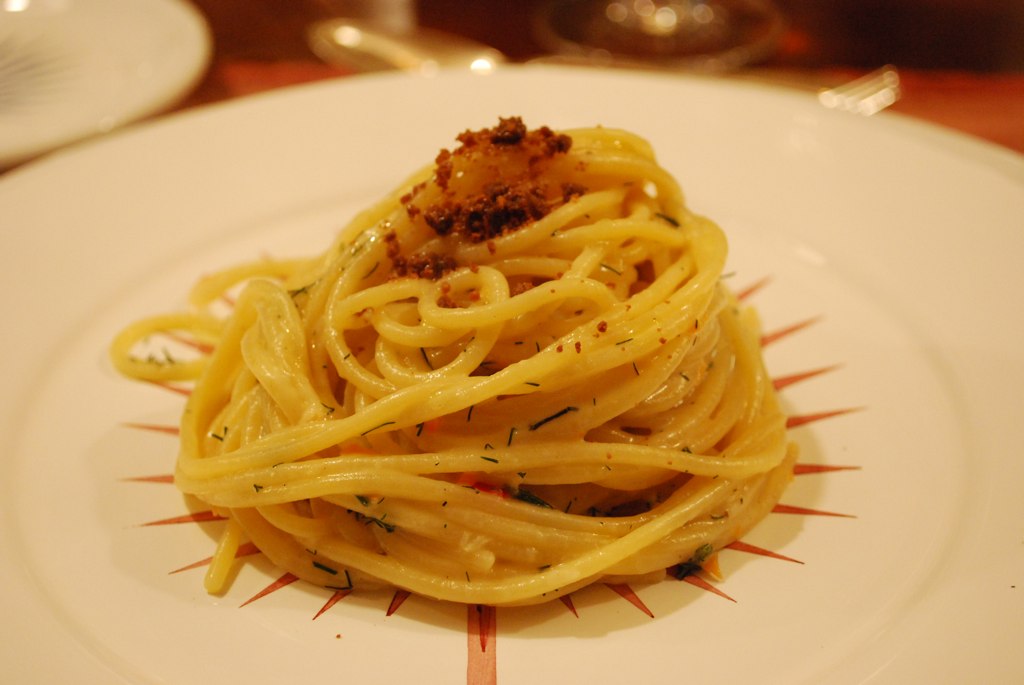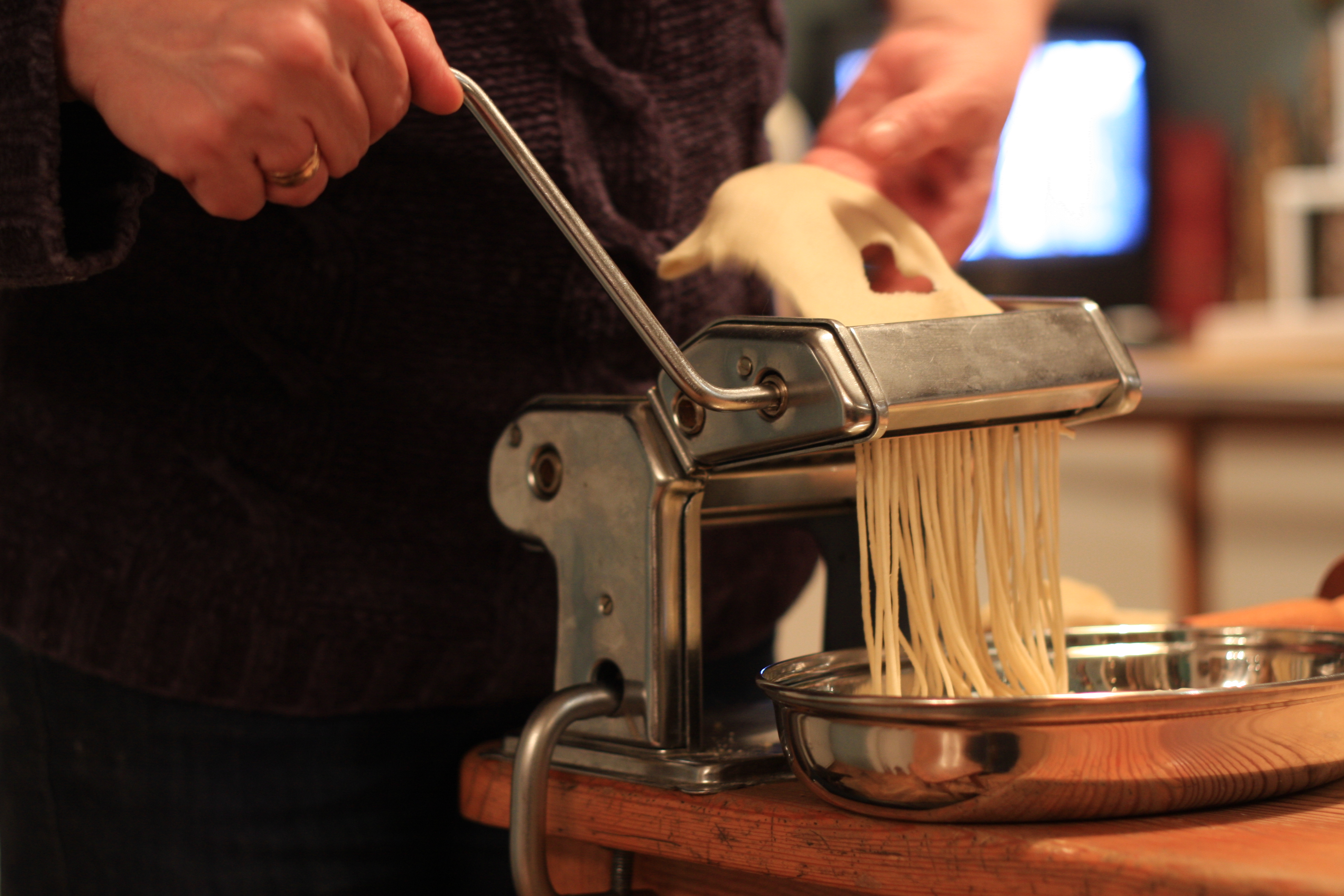|
Vermicelli
Vermicelli (, ; , literally "little worms"), is a traditional type of pasta round in section similar to spaghetti. In Anglosphere, English-speaking regions it is usually thinner than spaghetti, while in Italy it is thicker. It is typically made with semolina. Thickness comparison As defined in Italy, the diameters of spaghetti-like pasta are: ;vermicelli : between , with little variation between different producers. ;spaghetti : between . ; : () between . ; : between . ;capellini or : ( or ) between . In the United States, the National Pasta Association (which has no links with its Italian counterpart, the ) lists vermicelli as a thinner type of spaghetti. The Code of Federal Regulations of the United States of America defines spaghetti and vermicelli by diameter: ;vermicelli : less than . ;spaghetti : between . History In 14th-century Italy, long pasta shapes had varying local names. Barnabas de Reatinis of Reggio notes in his (1338) that the Tuscan vermicelli are calle ... [...More Info...] [...Related Items...] OR: [Wikipedia] [Google] [Baidu] |
Sheer Khurma
Sheer khurma or sheer khorma ( "milk and dates") is a festival vermicelli pudding prepared by Muslims on Eid ul-Fitr and Eid al-Adha in Pakistan, Afghanistan, and parts of India and Central Asia. It is equivalent to shemai, a Bangladeshi dessert. It is a traditional Muslim festive breakfast, and a dessert for celebrations. This dish is made from various dry fruits, vermicelli, condensed milk, sugar, etc. Depending on the region, cardamom, pistachios, almonds, cloves, saffron, raisins, and rose water are also added. This special dish is served on the morning of Eid day in the family after the Eid prayer as breakfast, and throughout the day to all the visiting guests. In its original form, it consists of dates mixed with milk from Iran and dry fruits and nuts from Afghanistan which is where it originated. It is modified in India by the addition of fried semia and caramelised sugar. Ingredients The main ingredients used in sheer khurma are vermicelli, whole milk, sugar, and dat ... [...More Info...] [...Related Items...] OR: [Wikipedia] [Google] [Baidu] |
Aletria
''Aletria'' is a custardy Portuguese cuisine, Portuguese dessert based on ''vermicelli'' (''aletria''). In the Beiras region, ''aletria'' has a compact consistency, and is able to be cut in slices, whereas in Minho Province, Minho its consistency is more creamy. Origin Llibre de Sent Soví, a set of two 14th-century manuscripts, in Catalan language, Catalan, contains a compilation of 200 recipes, of which there are two with ''alatria'' (170: ''Qui parla con se cou alatria'' or "how to cook vermicelli" and 171 : ''Qui parla con se cou carn ab alatria'' or "how to cook meat with vermicelli"). However, what they called vermicelli should have a very different shape from the current thin strands of dough. Vermicelli was probably brought to the Iberian Peninsula by the Moors in the 8th or 9th century. It remained in Portugal and incorporated into Portuguese cuisine, and began to designate the mass of very fine yarns, with which a typical Christmas candy, present in almost all regions o ... [...More Info...] [...Related Items...] OR: [Wikipedia] [Google] [Baidu] |
Pasta
Pasta (, ; ) is a type of food typically made from an Leavening agent, unleavened dough of wheat flour mixed with water or Eggs as food, eggs, and formed into sheets or other shapes, then cooked by boiling or baking. Pasta was originally only made with durum, although the definition has been expanded to include alternatives for a gluten-free diet, such as rice flour, or legumes such as beans or lentils. Pasta is believed to have developed independently in Italy in the Middle Ages, Italy and is a staple food of Italian cuisine, with evidence of Etruscan civilization, Etruscans making pasta as early as 400 BCE in Italy. Pastas are divided into two broad categories: dried () and fresh (Italian: ). Most dried pasta is produced commercially via an Food extrusion, extrusion process, although it can be produced at home. Fresh pasta is traditionally produced by hand, sometimes with the aid of simple machines.Hazan, Marcella (1992) ''Essentials of Classic Italian Cooking'', Knopf, F ... [...More Info...] [...Related Items...] OR: [Wikipedia] [Google] [Baidu] |
Martino Da Como
Martino da Como (or Martino de Rossi; Martino de Rubeis, called Maestro Martino from Como), born in the Blenio Valley (in the Italian speaking part of today's Switzerland), was a 15th-century culinary expert who was unequalled in his field at the time and could be considered the Western world's first celebrity chef. He made his career in Italy and was the chef at the Roman palazzo of the papal chamberlain (" camerlengo"), the Patriarch of Aquileia. Martino was applauded by his peers, earning him the epitaph of ''the prince of cooks''. His book ''Libro de Arte Coquinaria'' (''The Art of Cooking'') () is considered a landmark in Italian gastronomic literature and a historical record of the transition from medieval to Renaissance cuisine. w:it:Maestro Martino da Como Biography Maestro Martino was born around 1430 in Torre, a village in the Blenio Valley, then in the Duchy of Milan, today in Canton Ticino, Switzerland. His early career probably began in northern Italy, as he is refer ... [...More Info...] [...Related Items...] OR: [Wikipedia] [Google] [Baidu] |
Egyptian Cuisine
Egyptian cuisine makes heavy use of poultry, legumes, vegetables and fruit from Egypt's rich Nile Valley and Delta. Examples of Egyptian dishes include rice-stuffed vegetables and grape leaves, hummus, falafel, shawarma, kebab and kofta. Others include '' ful medames'', mashed fava beans; '' koshary'', lentils and pasta; and '' molokhiyya'', jute leaf stew. A local type of pita known as ( Egyptian Arabic: ) is a staple of Egyptian cuisine, and cheesemaking in Egypt dates back to the First Dynasty of Egypt, with Domiati being the most popular type of cheese consumed today. Egyptian cuisine relies heavily on vegetables and legumes, but can also feature meats, most commonly rabbit and poultry such as squab, chicken, duck, quail and goose. Lamb and beef are commonly used in Egyptian cuisine, particularly for grilling and in a variety of stews and traditional dishes. Goat and camel are also eaten but are not as readily available nationwide. Offal is also a popular ... [...More Info...] [...Related Items...] OR: [Wikipedia] [Google] [Baidu] |
Spaghetti
Spaghetti () is a long, thin, solid, cylindrical pasta.spaghetti Dictionary.com. Dictionary.com Unabridged (v 1.1). Random House, Inc. (accessed: 3 June 2008). It is a staple food of traditional Italian cuisine. Like other pasta, spaghetti is made of Mill (grinding), milled wheat, water, and sometimes Enriched flour, enriched with vitamins and minerals. Italian spaghetti is typically made from durum-wheat semolina. Retrieved on 22 December 2014. Usually the pasta is white because refined flour is used, but whole wheat flour may be added. ''Spaghettoni'' is a thicker form of spaghetti, while spaghettini is a thinner form. Capellini is a very thin spaghetti, while vermicelli refers to intermediate thicknesses. Originally, spaghetti was notably long, but shorter lengths gained in popularity during the latter hal ... [...More Info...] [...Related Items...] OR: [Wikipedia] [Google] [Baidu] |
Semolina
Semolina is the name given to roughly milled durum wheat mainly used in making pasta and sweet puddings. The term ''semolina'' is also used to designate coarse millings of other varieties of wheat, and sometimes other grains (such as rice or maize) as well. Etymology Semolina, attested since 1790–1800, is derived from the Italian word , an alteration of (, from Latin , ) with the diminutive suffix . The Latin word is of ultimate Semitic origin, with the original meaning of ; cf. Arabic (, ) and Aramaic (, ). Production Modern milling of wheat into flour is a process that employs grooved steel rollers. The rollers are adjusted so that the space between them is slightly narrower than the width of the wheat kernels. As the wheat is fed into the mill, the rollers flake off the bran and germ while the starch (or endosperm) is cracked into coarse pieces in the process. Through sifting, these endosperm particles, the semolina, are separated from the bran. The semolina is the ... [...More Info...] [...Related Items...] OR: [Wikipedia] [Google] [Baidu] |
Levant
The Levant ( ) is the subregion that borders the Eastern Mediterranean, Eastern Mediterranean sea to the west, and forms the core of West Asia and the political term, Middle East, ''Middle East''. In its narrowest sense, which is in use today in archaeology and other cultural contexts, it is equivalent to Cyprus and a stretch of land bordering the Mediterranean Sea in Western AsiaGasiorowski, Mark (2016). ''The Government and Politics of the Middle East and North Africa''. p. 5: "... today the term ''Levantine'' can describe shared cultural products, such as Levantine cuisine or Levantine archaeology". .Steiner & Killebrew, p9: "The general limits ..., as defined here, begin at the Plain of 'Amuq in the north and extend south until the Wâdī al-Arish, along the northern coast of Sinai. ... The western coastline and the eastern deserts set the boundaries for the Levant ... The Euphrates and the area around Jebel el-Bishrī mark the eastern boundary of the northern Levant, as d ... [...More Info...] [...Related Items...] OR: [Wikipedia] [Google] [Baidu] |
Somali Cuisine
Somali cuisine is characterized by aromatic spices and robust flavors, reflecting a distinctive blend of rich regional traditions and the influences of expansive trade networks established by Somali merchants, whose long monopoly on spices such as cinnamon has indelibly shaped its flavor profile. In recent years, Somali culinary traditions have gained increasing international recognition, with Somali-American chefs such as Ifrah Ahmed and Hawa Hassan drawing significant attention, a Somali restaurantaur earning a Best Small Business Person in the United States, and London establishments like Al Kahf and Sabiib emerging as popular destinations among food enthusiasts. Some notable Somali specialties include ''kimis'' / ''sabaayad'', ''canjeero'' / ''laxoox'', ''xalwo'' (halwa), ''sambuusa'' (samosa), ''bariis iskukaris'', and ''muqmad'' / ''oodkac''. Pork consumption is forbidden in Somalia in accordance with sharia, as the vast majority of the population are Muslims. Breakfast Break ... [...More Info...] [...Related Items...] OR: [Wikipedia] [Google] [Baidu] |






